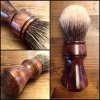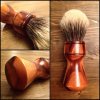File this one under daydream, a combination of working summers in construction decades ago and thinking about brushes. In other words, odds are I won't make one.
That said, I'm curious about wood handles. The idea of wood and moisture makes me think of split wood, discolored wood, and rotten wood. But there seems to be wooden handled shaving brushes, and wood is generally plentiful and easy to work with. First thought was cypress, then redwood, but both are softwoods and might not be suitable. Doubt these are used in handle making.
Finish is obviously an issue. A oil finish came to mind, followed by marine spar varnish. But the last time I used marine spar varnish, the odor was strong enough that it would make badger brush funk curl up and whimper. Next idea was gym floor polyurethane. Have seen that used on furniture before, so that's not necessarily a wild thought.
So, what is the preferred wood for shaving brushes? I assume it's a hardwood, but other than that haven't a clue. Also, what is the preferred varnish?
All just out of curiosity.
Odd thought: There were some non-woods coming on the market years ago that could be worked with woodworking tools. Has anyone tried these?
That said, I'm curious about wood handles. The idea of wood and moisture makes me think of split wood, discolored wood, and rotten wood. But there seems to be wooden handled shaving brushes, and wood is generally plentiful and easy to work with. First thought was cypress, then redwood, but both are softwoods and might not be suitable. Doubt these are used in handle making.
Finish is obviously an issue. A oil finish came to mind, followed by marine spar varnish. But the last time I used marine spar varnish, the odor was strong enough that it would make badger brush funk curl up and whimper. Next idea was gym floor polyurethane. Have seen that used on furniture before, so that's not necessarily a wild thought.
So, what is the preferred wood for shaving brushes? I assume it's a hardwood, but other than that haven't a clue. Also, what is the preferred varnish?
All just out of curiosity.
Odd thought: There were some non-woods coming on the market years ago that could be worked with woodworking tools. Has anyone tried these?

